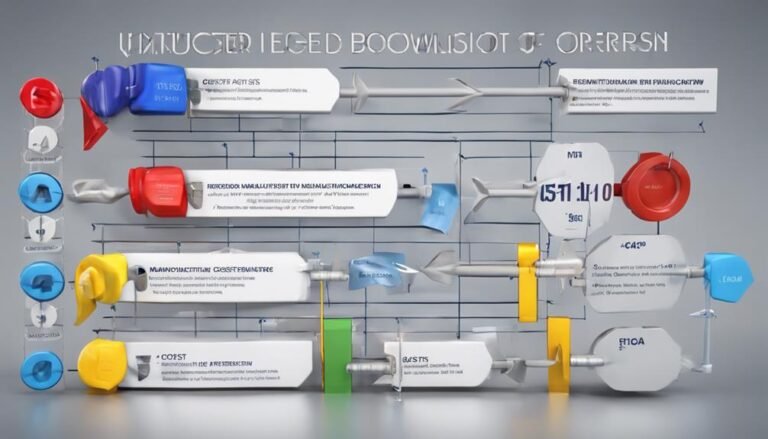Disruptive Innovation: Meaning and Examples
Disruptive innovation transforms industries by introducing new products, challenging norms, and utilizing innovative business models and technologies. It represents a strategic shift that reshapes competitive landscapes and demands adaptation to emerging trends for success. Examples like Amazon, Netflix, smartphones, Google, and Meta showcase its power in revolutionizing markets and displacing established players. To thrive in disruptive environments, businesses must tap into overlooked markets, leverage technology, and establish partnerships for growth. Embracing unconventionality is key to harnessing the potential offered by disruptive innovation. Explore further to uncover the transformative impact and strategic significance of disruptive innovation.
Key Takeaways
- Disruptive innovation transforms industries with new products and business models.
- Examples include Amazon, Netflix, smartphones, Google, and Meta.
- It challenges traditional norms and reshapes competitive landscapes.
- Leveraging transformative technology in overlooked markets is crucial.
- Success demands agile adaptation to emerging trends and technologies.
Definition of Disruptive Innovation
In the domain of business evolution and market dynamics, the concept of disruptive innovation emerges as a transformative force reshaping industries and redefining competitive landscapes.
Market transformation occurs when disruptive innovation challenges established norms by introducing new products or services that cater to previously overlooked markets. This innovation strategy focuses on creating value through innovative business models that target new or underserved customer segments.
By leveraging enabling technologies and building coherent value networks with supportive partners, disruptive innovation accelerates market disruption and drives significant changes in industry structures.
Companies that embrace disruptive innovation gain a competitive edge by adapting to evolving consumer needs and preferences, ultimately securing a foothold in the ever-changing business landscape.
Characteristics of Disruptive Innovation
Disruptive innovation, with its transformative impact on industries and competitive landscapes, embodies a strategic paradigm shift in business evolution. This type of innovation leverages transformative technology to create opportunities in overlooked markets. By focusing on these untapped segments, disruptive innovation challenges traditional business models and opens up new avenues for growth.
The key lies in identifying enabling technologies that can redefine value propositions and reach previously underserved customers. Disruptive innovation thrives on reshaping industries by offering affordable and accessible solutions that cater to a broader audience. It disrupts the status quo, pushing established players to adapt or risk becoming obsolete. Embracing this approach requires a keen eye for emerging trends and a willingness to explore unconventional paths to success.
Understanding Disruptive Innovation
With a transformative impact on industries and competitive landscapes, disruptive innovation represents a strategic paradigm shift in the domain of business evolution. Market impact is an important aspect of disruptive innovation, as it involves introducing new products or services that fundamentally change the way business operates within a specific industry. This transformation often leads to the displacement of established competitors and the creation of new market dynamics.
Business adaptation is key for companies to thrive in the face of disruptive innovation. They must be agile and willing to embrace change, adjusting their strategies, operations, and offerings to align with the evolving landscape. Successful adaptation to disruptive technologies can result in significant growth and competitive advantage in the market.
Requirements for Disruptive Innovation
Revolutionizing industries and reshaping competitive landscapes, the essential prerequisites for fostering groundbreaking innovation lie in tapping into overlooked markets and harnessing transformative technologies.
When initiating a journey of disruptive innovation, consider the following:
- Igniting Potential: Harness the power of transformative technology to discover new possibilities and redefine industry standards.
- Embracing Unconventionality: Explore overlooked markets with unmet needs, where disruptive solutions can make a significant impact.
- Forging Alliances: Establish a robust network of partners aligned with the vision of the innovative business model, ensuring mutual growth and sustainability.
Examples of Disruptive Innovation
In the sphere of business evolution, innovative companies have harnessed transformative technologies to reshape industries and redefine market dynamics. Market transformation through the digital revolution has seen industry disruption on a monumental scale.
Examples of disruptive innovation include Amazon's restructuring of the bookselling industry, where traditional brick-and-mortar stores were challenged by the online giant. Netflix revolutionized TV viewing, disrupting the traditional cable model. Smartphones have transformed the tech industry, replacing laptops and desktops with portable, multifunctional devices.
Companies like Google and Meta embraced the internet as a disruptive technology, changing the landscape of information access and connectivity. These instances highlight the profound impact of innovation on established markets, illustrating the power of forward-thinking strategies in driving change.
Conclusion
To sum up, disruptive innovation revolutionizes industries by making once exclusive products and services accessible to a wider audience. This transformative force relies on innovative business models, enabling technologies, and a robust value network to displace established market players.
An interesting statistic to note is that 77% of executives believe that their current business models will not survive without adopting disruptive innovation strategies. This underscores the critical importance of embracing disruptive technologies to stay competitive in today's fast-paced business environment.







